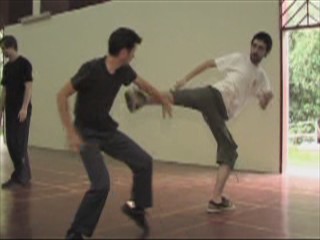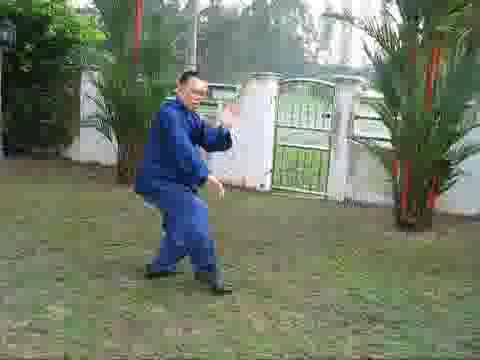SELECTION OF QUESTIONS AND ANSWERS
MARCH 2012 PART 3

Students at a chi kung course during the UK Summer Camp 2011 enjoying a chi flow
Question 1
Sifu, am I correct to say that when I perform my Kung Fu and surrender myself to God and let God guide my actions, this is right?
— Wei Joo, Malaysia
Answer
Yes, this is right. God will always act for your best interest. In chi kung terms, this is called "wu-wei".
Question 2
Some Christians may not feel comfortable with the idea and concept of chi.
Answer
This is because they mistakenly think that chi kung is a Taoist or Buddhist ritual. If they realize that chi means energy, they may be less uncomfortable. And if they know that they themselves are actually a body of chi, they may begin to be interested.

Systematic sparring practice is necessary before entering a sparring competition
Question 3
If I say that they surrender themselves to God (let go), relax, and let God guide them, is it the same as relaxing and letting go? Can chi be directed by a higher, universal self, God? Is it true that when we do our chi flows, God is showering His love and blessings on us?
Answer
Yes, surrendering themselves to God, relax and let God guide them is the same as relaxing and letting go. Chi can be directed by God. Enjoying a chi flow is like receiving the love and blessings of God.
Indeed, that is actually what we do in Cosmic Shower. We open ourselves and let the grace and blessings of God flow through us.
God is all compassionate. He gives His blessings to everybody. Then, why many people are sick and suffer? Don't blame God. It is they who close themselves and block the blessings of God. Cosmic Shower is an excellent chi kung exercise to open the blockage and let the blessings of God flow through.
Question 4
I have attached three videos from a full-contact tournament. I lost the first round, won the second, and lost the third. I'm not upset about losing the match, but I am disappointed with my performance and my inability to use kung fu techniques effectively and consistently.
In all fairness, I really shouldn't be that disappointed with the fight considering my training leading up to it was not what it should have been. Robin Sisook laid out a plan for preparing for an event like this starting with a training partner then eventually going to a gym that trained full contact sparring.
You also laid out a guideline in Costa Rica of starting with easy opponents and gradually fighting more and more skillful people. I didn't follow either of those suggestions. I partly wanted to see where my skill level was and how I would perform without specific training. I found out.
— Adam, USA
Answer
Considering that you haven't followed my advice in preparing for free sparring with other martial artists, what you did was quite good. Indeed your result was better than expected. Someone else could be devastated.
The remedy is very simple. Follow my advice in sparring with other martial artists from class 3 to class 2 to class 1. You will be as equally surprised with your poor result due to not following my advice as with your good result due to following my advice.

"White Snake Separates Grass" from Wudang Taijiquan
Question 5
I received a call today from one of my very first students. He said that his friend was just diagnosed with lung cancer. He was wondering if I knew of any Shaolin Wahnam healers in the area.
If there are no healers locally, and he is unable to relocate for a year, I am going to highly suggest he applies for your next Intensive Chi Kung course in April.
Should I also suggest that he begins training in Shaolin Kungfu with me, as well? I feel Kungfu could help, but I certainly don't want to do anything to make things worse.
— Sifu Matt Fenton, USA
Answer
Tell your student's friend that cancer can be cured. I am very sure of this.
This does not mean that every cancer patient will be cured. In the same way, everyone can be a millionaire, but it does not mean that everyone will be a millionaire.
But there is a big difference in believing that cancer is incurable and that cancer can be cured.
The most important factor for curing cancer is that the patient himself wants to be cured, and that the healing he is undergoing will cure him. This statement may sound funny, but it is an earnest statement of truth. Doesn't every cancer patient want to be cured?
By wanting to be cured, I mean that the patient wants it enough to really do something about it, including investing time and money. If you, with a good track record of helping many cancer patients recover, tell a patient that if he comes to your clinic everyday for healing, he can be cured, but he thinks that it is too troublesome and wants to do the healing in his own house, then he does not really want to be cured.
If you tell him that the healing fee is $10,000, for which he receives healing sessions everyday for a year or until he is cured, which may be far less than a year, otherwise the full fee will be refunded, but he thinks it is expensive and wants you to heal him for free, then he doesn't really want to be cured.
We have excellent healers in the U.S., like Anthony Spinnichia, Gusty, Joshua and Molly. Seeing any one of our healers and following his instructions is the best chance for your student's friend to be cured of cancer. The second best chance, but much less than the first one, is to attend my Intensive Chi Kung Course and continue to practice at home.
The third best chance is to learn chi kung from you, for which he must be willing to pay a high fee, and practice everyday. It may be difficult for most people to comprehend, but paying a high fee is more for his benefit than for you. If you teaches him for free or charges him a norminal fee, it is unlikely he will recover (even when you teach him the same thing for a very high fee).
Although it is the thrid best choice for him, he still has a chance to recover -- note: recover, not just survive with the disease. It is certainly better than seeking treatment from someone who believes that cancer cannot be cured.
Question 6
I have found from experience that I can perform better when I am in a chi flow. But there are occasions when performing chi flow may not be appropriate, like while talking to a client. What should I do?
— Sifu Mauro, Switzerland
Answer
Here you are referring to a formal chi flow like in a chi kung class where you move visibly and often vigorously.
You can have an informal chi flow where there is no obvious bodily movement. Just relax and gently think of a good chi flow down from your head through you body and arms to your legs. You will be fresh and energized, and be able to accomplish better results no matter what you do, including talking to a client.
If it is feasible, you can also have a formal chi flow before you meet your client, or do any thing. You will have better results.

An application of "Black Bear Circles Palm" from Wudang Taijiquan to counter an Aikido wrist-lock
Question 7
Could you please explain the development of Wudang Taijiquan and its connection to Shaolin?
— Sifu Daniel Perex, Spain
Answer
Wudang (pronuced like /wu-tang/ in English) Taijiquan was developed by Zhang San Feng, who graduated from the Shaolin Monastery in Henan. At first it was not called Wudang Taijiquan; it was called Shaolin Kungfu.
To differentiate it from the Shaolin Kungfu practiced at the Shaolin Monastery in Henan, it was called Wudang Shaolin Kungfu. Gradually it was shortened to just Wudang Kungfu.
A few hundred years later a scholar-general, Chen Wang Ting, used the Taiji principles of yin-yang to explain the philosophy of Wudang Kungfu. Hence it was called Taijiquan, meaning Taiji or Cosmos Kungfu.
To differentiate the two styles of Taijiquan practiced on the Wudang Mountain and at the Chen Family Village, the terms Wudang Taijiquan and Chen Style Taijiquan were used. Later, Yang Style Taijiquan developed from Chen Style, and Wu Style and Sun Style developed from Yang Style.
The Wudang Taijiquan practiced by Zhang San Feng was Shaolin Kungfu at its highest level. Zhang San Feng integrated kungfu, chi kung and Zen into one unity, and performed it in an exquisite, flowing manner, aptly described as poetry in motion. It is excellent for health, combat and spiritual cultivation -- all in one.
Question 8
Which are the special features of Wudang Taijiquan and how did Zhang San Feng evolved this art from his past experience?
Answer
A very special feature of Wudang Taijiquan is that kungfu, chi kung and meditation are integrated into one unity. In other words, when a practitioner practices Wudang Taijiquan, he is practicing kungfu, chi kung and meditation at the same time.
This was a tremendous development in the history of kungfu. Hence, Zhang San Feng is honoured as the First Patriarch of Internal Martial Arts.
Previously a Shaolin Kungfu practitioner first practiced physical form. After he had attained a reasonably high standard, usually after many years, his teacher would teach him chi kung; or the art of energy. Then after he had attained a reasonably high standard in kungfu and chi kung, again after many years, his teacher might teach him meditation, or the art of mind training. Zhang San Feng integrated all these three arts into one so that even a beginner in Wudang Taijiquan could practice combat training, energy training and mind training as a coherent whole right at the beginning.
Zhang San Feng could do this because he was a master of all these three arts. Zhang San Feng excelled in various styles of Shaolin Kungfu, like dim mark and chin-na, numerous internal force methods, like Sinew Metamorphosis, Small Universe, Big Universe, Phoenix-Eye and Cosmos Palm. as well as many meditation techniques, like samadha, vispasana and Zen. He made full use of all these arts to develop Wudang Taijiquan.
Another special feature of Wudang Taijiquan is its flowing movement. Its patterns are not performed individually but flow continuously in a sequence. The whole set, consisting eight sequences, is performed as if it consists of only eight long patterns.
The third feature is its "softness". There seems to be no "hard" patterns in Wudang Taijiquan, whereas Shaolin Kungfu from which Wudang Taijiquan evolved was comparatively "hard". Being soft and flowing, of course, does not mean it is not forceful. Indeed, Wudang Taijiquan can be very powerful. It is high-level Shaolin Kungfu. While Shaolin Kungfu at its elementary and intermediate levels is "hard", it can be very "soft" and flowing at advanced levels.
LINKS
Selected Reading
- On God, Buddha and Immortals
- Participating in and Winning Free Sparring Competitions
- Facts and Oppinions
- Good Health is Our Birth-Right
- Early Shaolin Combat Sequences in the 1980s
